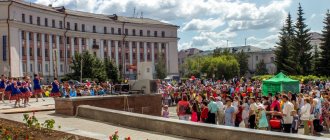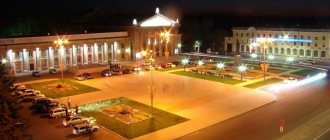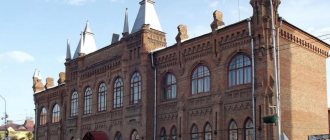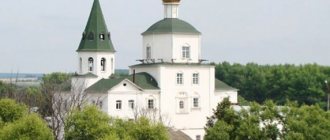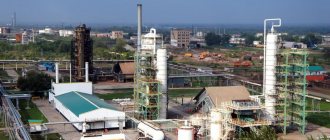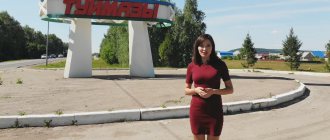1K 4 min.
Celebrating its 300th anniversary this year, Polevskaya, despite its relatively small territory and population, is known primarily as a source of inspiration for the Ural writer Pavel Bazhov. In addition, there is a unique monument of industrial tourism - the Severskaya blast furnace, built in 1860. The city-forming enterprise is the Seversky Pipe Plant.
View of the city of Polevskoy
Photo: Press service of the Seversky Pipe Plant
Story
The city received its name from the Polevaya River, on the banks of which a deposit of copper ore was discovered. Presumably, in the 1st millennium BC, during the early Iron Age, the active use of copper ore and the settlement of the region by tribes of metallurgists of the Itkul culture began here. The main source of ore mining was Copper Mountain (Gumeshki). The deposit was rediscovered in 1702 by ore explorers Sergei Babin and Kozma Suleev, and in 1718 its industrial development began. This date is considered the official founding date of Polevsky. City Day is traditionally celebrated on the third Sunday of July simultaneously with Metallurgist Day. In 1722, Peter I issued a decree in which he ordered the manager of the Ural mining plants, Wilhelm de Gennin, “...beyond Chusovaya, near the Polevye Rechki, to build a copper plant, a fortress and a trench to guard this plant...”. In 1724, construction of the Polevsky copper smelter began here (now the Polevsky Machine-Building Plant). Soon, iron ore was discovered in the area, and in 1735–1739, the construction of the Seversky Ironworks (now the Seversky Pipe Plant) began on the Severushka River. In 1738, here, in the area of the present village of Mramorskoye, the first industrial development of marble in the Urals began. Since 1803, gold deposits have been discovered around the city. In March 1942, Polevskoy received city status, and in 1946 it became a city of regional subordination. In 1996, based on the results of a referendum, the municipal formation “City of Polevskoy” was created, and since 2006 - Polevskoy urban district. Polevskoy itself became a single-industry town of the third category - a city with a stable socio-economic situation.
Sights of Polevsky
Before the entrance to the city there is a “Polevskoy” stele with an image of a stone flower and a lizard. Nearby there is a marble sundial - similar to those in the village of Mramorskoye. They were installed in 1986 by veterans of the Marble Plant. There is also a rest area with benches and a canopy.
Let's begin our acquaintance with the city of Polevsky from its southern part. More of the “old” city has been preserved here than in the northern part; private houses predominate.
In January 2022, the building of the Polevsky bus station (Volodarsky St., 72) was decorated with magnificent 3 D graffiti . Artists from the Yekaterinburg team Spektr painted historical artifacts from museums in the city, one way or another connected with Polevsky. Volumetric graffiti on the bus station building is dedicated to mineralogy. Here you can see balls of white marble and malachite, quartz druses, samples of brown iron ore, native copper and cuprite.
Across the road, on a 5-story building on the street. Volodarskaya, 57, you can see bird-shaped idols of the Itkul culture, which were found by schoolchildren in 1940 on Azov Mountain.
On the right, on the transformer booth, there is a three-dimensional model of the Polevsky plant, and from the end there is a plan of the Polevsky plant in 1734.
On Bazhov Square on Karl Marx Street there is a monument to the writer P.P. Bazhov . It was opened in 1983, made of pink Karelian granite according to the design of L.I. Kruzhalova. Behind the monument is the building of the Bazhov Center for Children's Creativity.
On the other side is the pedestrian street Troyan, which ends a block later in front of the Center for Culture and Folk Art . Behind it is a city park created on the site of an old cemetery.
Polevskoy began with a dam . This is the very “heart” of the city. After the creation of the dam, a pond appeared on the Polevaya River. Nowadays, the length of the Polevsky (Upper) pond is about 3 km, the width is 1.1 km. There is an island on the pond called Rybachy.
Not far from the dam you can see the Church of Peter and Paul (3 Kologoydy St.), an architectural monument of the 18th century. Construction of the church began in 1786 and was consecrated in 1793. In 1941 the church was closed. According to legend, church treasures were hidden in an underground passage leading from the temple. During the Great Patriotic War, the building housed evacuees from Moscow. From 1961 until the end of the 1980s, the building housed a bus station. In the 1990s, the church was returned to the Russian Orthodox Church and restored.
At the beginning of Ilyich Street there is a former house of managers of the Polevsky plant . Alas, he is now in a depressing state.
On the other side of the dam (Shkolnaya St., 1) there is a beautiful building of the Cherkashinsky meat processing plant , reminiscent of a palace. In the past, the office of the Polevsky plant stood on this site.
On the street Shkolnaya, at the foot of Dumnaya Mountain, there is a marble processing enterprise. Previously, there was a building for a primary women's school . P.P.’s parents lived in his outbuilding in 1890-93. Bazhova. Pavel Bazhov himself spent his summer holidays here.
Turning onto the street. Boboshin, and then to Svoboda, you will climb Dumnaya Mountain , which rises on the right bank of the Polevaya River. The height of the mountain is 405 m above sea level. According to popular legend, the mountain was named because during the Peasant War the Pugachev atamans stood and pondered on it. According to other legends, behind Dumnaya Mountain there were secret underground passages.
At the top of the mountain, on the day of the 10th anniversary of the liberation of the Urals from Kolchak, on July 15, 1929, a monument to the heroes of the Civil War was unveiled at the mass grave. Here is a picture of a worker holding a rifle with a bayonet in his right hand and a hammer in his left. Similar monuments, made according to the model of sculptor K.A. Klodt and cast at the Kasli plant, there are also in a number of other cities of the Urals: Revda, Sysert, Kasly, Upper Ufaley, Lower Ufaley.
From the top there is a view of the city, Azov Mountain is visible on the horizon. In 2011, a 6-meter metal cross was erected on the mountain. In the past, there stood the Ascension Chapel, built in 1808. The religious procession took place here. In the 1920s, the chapel was demolished.
In the 1st millennium BC, copper ore was mined at the foot of Dumnaya Mountain. At the top there was a copper smelting production complex, surrounded by a moat and a wooden palisade. The area of the fort is 1700 m2. Later, the copper deposit was used by the Polevskoy copper smelter. P.S. Pallas wrote:
“This ore mountain was once processed by a people unknown to us, whose diligence and knowledge in mining... is evidenced by numerous traces... here in the collapsed ancient mines.”
In 1949-51, archaeological excavations were carried out here by E.M. Bers, and in 1981-84 - archaeologists from USU under the leadership of V.E. Stoyanov and G.V. Beltikova. According to their conclusion, the ancient metallurgists came here in the 5th century BC. from the shores of Lake Isetskoye.
To guard the wood warehouse on Dumnaya Mountain there was a guardhouse, where the old man V.V. told his stories to young Pavel Bazhov. Khmelinin. Mount Dumnaya is a natural monument of the Sverdlovsk region.
On the street Ilyich, 93 there is the Polevskaya Historical Museum (tel. (34350) 2-08-69). The museum contains the following exhibitions: Archeology of the Polevsky region, Bazhovs in Polevsky, History of Polevsky until the 20th century, History of Polevsky in the first half of the 20th century. There is a stationary mechanical planetarium.
Several old merchant houses have been preserved on Ilyich Street.
There are also interesting places in the northern part of the city (although almost no old civil buildings have survived here). The main attraction here, of course, is the Severskaya Blast Furnace museum complex (Vershinina St., 7, tel. (34350) 3-26-37, 3-20-36). Includes two historical buildings, an open-air exhibition and the Transfiguration Chapel. The blast furnace shop building has remained almost unchanged since 1860. It is a unique object of industrial architecture. The Seversk blast furnace is considered the only industrial complex in Europe from the mid-19th century, which is in a high degree of preservation and gives a complete picture of the production process of that time. It is an object of history and culture of federal significance. Some scenes of Yaropolk Lapshin’s film “The Demidovs” (1983) were filmed here. You can read about the blast furnace itself in a separate article.
The entrance to the museum complex is located near the shore of Seversky Pond. To the right of the entrance to the museum complex is the Transfiguration Chapel . It is considered the only chapel in the world made entirely of metal. I will not claim that this is so. The chapel was built in 1892 and consecrated in 1894. However, in 1932 it was destroyed and melted down. In 2001, the chapel was recreated using old drawings and photographs. At first it stood near the plant on the street. Vershinin, in 2013 the chapel was moved to the Seversk blast furnace.
Seversky Pond is quite picturesque. Azov Mountain is visible behind it. Alas, the environmental situation in Polevsky is far from ideal. So on the pond there is often a massive death of fish due to water pollution.
On a hill not far from the plant you can see the Holy Trinity Church . It was founded in 1811 and consecrated in 1816. In 1892, reconstruction of the temple began with the purpose of expansion, which continued until 1902. During Soviet times, the church was closed. In 1932, the building housed a club. Now the temple is operational. Nearby stands a marble monument in memory of the victims of the Civil War.
If you walk further along Mayskaya Street (until the intersection with Stepan Razin), you will come to the Ascension Chapel . It was opened in 2009. Made according to the design of B.N. Vetluzhsky. Made of iron, has round windows. Once a year a religious procession takes place here.
On the street Vershinina, 29a there is another 3D graffiti. Here is a model of a barque . Before the construction of railways in the Urals, factory products were shipped along rivers on such ships.
Near the reinforced concrete products plant you can see the local Eiffel Tower (Trubnikov St., 3/1). Its height is 10 meters, weight is 496 kg. Installed in 2005, in honor of the 60th anniversary of the plant. Architect – B.N. Vetluzhsky.
Geography
Polevskoy is located 35 km southwest of Yekaterinburg on the eastern slopes of the Middle Urals. There are 14 settlements in the Polevsky urban district. The total area of municipal land is more than 155 thousand hectares, of which 9.4 thousand hectares are lands of settlements. According to data for 2022, the permanent population is 69.7 thousand people. On the territory of the municipality there are deposits of: copper ore, limestone, sand, granite, demantoid, serpentinite (coil), malachite, rhodonite, iron ore, gold, marble, nickel.
How to get to Polevsky?
By car you need to leave Yekaterinburg along 8 March, Titova, Selkorovskaya streets on the Polevskaya tract and go to Polevsky. Distance from Yekaterinburg – 57 km. You can easily get there by regular bus from the Southern Bus Station of Yekaterinburg.
Along the way you can see the Europe – Asia obelisk and the village of Kurganovo. In the vicinity of Polevsky it is worth visiting Azov Mountain and White Stone, Glubochinsky Pond and the Kamennye Lipa waterfall, and the villages of Kosoy Brod and Mramorskoye.
References:
Arkhipova N.P. Natural attractions of Yekaterinburg and its surroundings. – Ekaterinburg, 2001. Karpov Stanislav. Traveling around the Polevsky region. – Polevskoy, 2014. Polevskoy – Wikipedia
Pavel Raspopov
UraloVed.ru
Municipal government
Polevskoy is headed by the head of the city administration, Konstantin Pospelov. He was elected at the end of 2022 by the city council. The Duma, consisting of 20 deputies, is headed by Ilya Kochev.
Coat of arms The coat of arms was originally approved on June 11, 1998. Re-approved on June 8, 2006 as the coat of arms of the Polevsky urban district. In a silver (white) field there is a green stone flower with a crowned golden (yellow) lizard; in the upper left corner of the shield there is an eight-pointed star, and in the lower right corner there is a ring connected at the bottom with a widened cross: both figures are of a shadow color. In accordance with the methodological recommendations for the development and use of official symbols, it is allowed to use an additional element in the coat of arms of the Polevsky urban district - a golden tower crown with five teeth. The stone flower is a masterpiece made from malachite by master stonecutter Danila, the main character of the work of the same name by Pavel Bazhov. As part of the coat of arms of the city district, this element symbolizes the talent and hard work of the field craftsmen. The crowned lizard is a zoomorphic image of the Mistress of the Copper Mountain, one of the central characters in Bazhov’s tales. The image of the "sign of Venus", also known as the "mirror of Venus", traditionally represents copper in alchemy. The image of a star with eight rays, used as the emblem of the Seversky plant, according to one version is identified with the Polar (Northern) star, and according to another, it symbolizes the wind rose, where north is the main reference point for the cardinal directions.
Population[ | ]
| Population | ||||||||
| 2002[18] | 2009[19] | 2010[20] | 2011[21] | 2012[22] | 2013[23] | 2014[24] | 2015[25] | 2016[26] |
| 74 124 | ↘72 178 | ↘71 220 | ↘71 163 | ↘71 067 | ↘71 058 | ↘70 704 | ↘70 619 | ↘70 358 |
| 2017[27] | 2018[28] | 2019[29] | 2020[30] | 2021[5] | ||||
| ↘70 233 | ↘69 729 | ↘69 041 | ↘68 605 | ↘67 473 | ||||
Budget
Budget revenues of the Polevsky urban district in 2022 are planned in the amount of 2 billion rubles, expenses are also projected at the level of 2 billion rubles. At the end of 2022, budget revenues are estimated at 1.8 billion rubles, expenses - at 1.9 billion rubles.
Industry The city-forming enterprise is the Seversky Pipe Plant (part of the Pipe Metallurgical Company). Also operating in the district are Polevskoy metal fittings and Uralhydromed. At the end of 2011, a hot-dip galvanizing plant for metal structures was built - the Ural Hot-Dip Galvanizing Plant. In June 2012, factories for the production of ground marble "Omia Ural" and for the production of dry building mixtures "Saint-Gobain Construction Products Rus" were opened.
Polevskaya on the map of Russia: geography, nature and climate
The city of Polevskoy can be found on the map of Russia in the Sverdlovsk region, 40 kilometers south of Yekaterinburg.
The conventional border of Europe and Asia runs through Polevsky’s territory. The city is located between the heights of the Ufaleysky ridge and the ridge of hills of the Kasli-Sysertsky ridge , so strong gusty winds and hurricanes practically do not happen here.
The climate is temperate continental with fairly cold winters, cool summers, warm springs and rainy autumns.
Polevskoy is surrounded by mixed and coniferous forests.
Air humidity is increased by reservoirs: the Chusovaya River with its tributaries, city ponds, and the Verkhne-Makarovskoye Reservoir .
